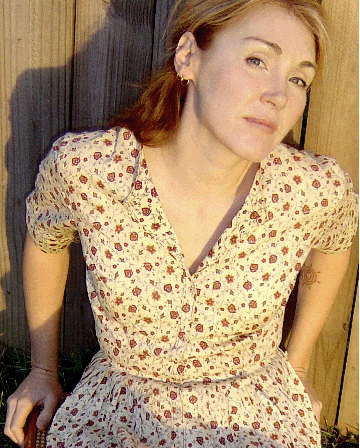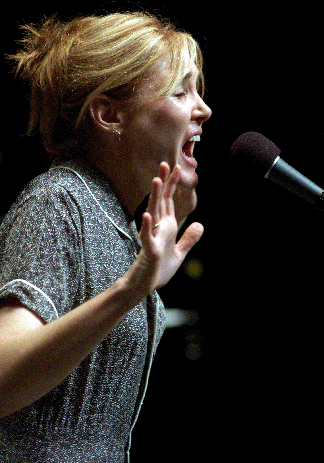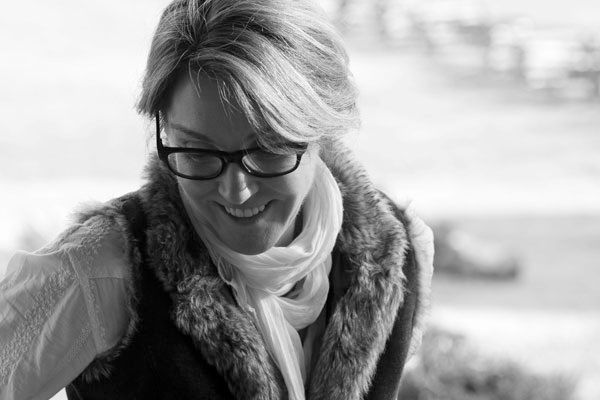Diana Jones
The Long Journey Home

The guitar picks and rolls in a easy, loping gait, like the rhythm of a horse in
motion. If you're familiar with the song and you know what's coming, the
chills begin immediately. The singer's voice is a husky southern drawl and it
pulls you into the narrative. It has a distinctive old-timey quality, kind of like
a softer version of Iris DeMent. She taps her foot in time and sways gently. As
Diana Jones sings "Pony," her song about a native American Indian girl taken
from her family in the 1920's to be "re-educated" at a white school, a sadness
permeates the air, carried in every syllable. It's 10 years into the narrator's
"education" as the song begins:
When they signed the papers / they didn't think I knew
Didn't know I understood / what they were told to do
By some white man that came by / the reservation one night
My daddy called me Pony / He loved me, I know
We went riding in the snow…
And more memories spill through the years…
Winter in Dakota / The hills are cold and white
I can close my eyes / and fix them plainly in my sight
And I see them in my sleep / through the window of my dreams
As her voice fades away at the song's end, chanting "hey-hey-hey-hey" in the
girl's reverie of her lost home and family, the last sound we hear is of a heart
breaking. It isn't just Diana's or the song's protagonist. It's our own.
With her straightforward manner and quiet charm, her loveliness sneaks up
on you. Her fashion style is simple and understated, favoring conservative
dresses. However, with her wide cheekbones, a level gaze emanating from
wide, guileless eyes and poetic truth oozing from every pore, she is…
impossibly beautiful.
The song, "Pony," comes out of Diana's fondness for historical non-fiction ,
her own history and that of her grandfather. She was adopted in infancy and
spent the early part of her life looking for the missing parts of herself and then,
eventually, her birth family.
Beginnings

love with left her. She went back to Tennessee, but being involved in civil &
equal rights, she felt Tennessee (especially in the 60's) wasn't right for her or the baby. She needed to get out and felt that leaving Diana in Tennessee would not be a great idea. Scared and alone, she decided to put Diana up for
adoption in NY where she thought things (socially, politically) were better.
The first eight years of Diana's life were spent in Valley Stream, Long Island.
Her adopted father worked for a chemical corporation and they moved around a lot… New Jersey, then Rhode Island… When Diana was 15, she left her foster family. She had been going to this "weird hippie school" in
Providence, Rhode Island and had a teacher who needed help with her two year-old, so Diana moved in with her teacher as "kind of" a nanny. "Beinghippies," she said, "they had a great record collection." She had listened to her foster father's records… Louis Armstrong and the like, and was always singing at home and in school chorus. When she was 6, a nun in her Catholic school came into her class and picked her out to sing in the 12-year-old chorus. She found that both exhilarating and scary.
She got a guitar when she was seven and played in folk mass, honing her guitar skills. The problem with the church, however, was that she found a lot of it boring because most of it existed, as she said, "on two minor chords and it had no melody."
Exhibiting her independence early, she joined a Baptist choir when she was 11 because their songs were more interesting. It was also at this time that she started writing "a song a week" (religious in nature) and taking it to a church prayer meeting she was involved with, teaching those songs to the singers there. "It was a little assignment I gave myself," she says, illustrating a recurring theme in her life. When she was just 12 or 13, she had pilfered records from her adopted brother.
He had wound up with the Johnny Cash and Emmy Lou Harris stuff. Although she listened to James Taylor and such on the radio and liked it, she felt more drawn to the more rootsy sounds of performers like Cash and Harris. She found later, when she discovered her birth family, that her grandfather had been a picker and singer. He had started his first band with Chet Atkins when he was 15 years old. They played the dance hall circuit sponsored by Cas Walker, a radio personality. Others who got early exposure that way included Dolly Parton, The Everly Brothers and Jim Nabors (TV's Gomer Pyle).
Speaking about her move from her adopted parents, it was the longing for belonging (not looking like anyone else in the family, among other things) plus her "quirky" artistic nature that fed the desire to find her birth family. At 16-17 years old, she attended support groups for adopted persons and other people who were searching and met some birth mothers and found it to be an amazing experience. Diana graduated from Sarah Lawrence with a degree in Fine Arts and American History
While she was still playing music during her school years, after graduation, she became a serious painter. In college, fortuitous coincidences and forshadowings started to pile up. She had been doing folk music with friends at open mics at the coffeehouse at the college. She played in a duo with a woman who was a "great guitar player" and formed a strong bond with her. They had both been adopted from the same adoption agency, four months apart. "We could've had each other's parents," she says. She also met two women there who, as she found out later, were from the same town that her family had settled in. Those women sang in a Louvin Brothers style harmony that affected her deeply.
Someone helping her search told her that she "had such a Southern face." When Diana mether birth family and looked at their faces, she found that there was some truth to this, perhaps owing to the Creek and Cherokee Indian bloodlines in her family's heritage. Diana wasn't able to conduct a full-out search until after college. She had gone to college on a scholarship and didn't have the financial resources. Having her own phone and being able to make a lot of phone calls was beyond her. After graduation, she started saving money. Betty Jean Lifton, a well-known adoption counselor and author, helped lead Diana to her family. When she started her search full-on, it took her only four weeks to track down her family. Diana had been on the phone with distant relatives from different parts of the country (she knew the family name), but "there were too many of them all over the place." She needed to know what state her family was from. Down to her last options, she says that she had a dream on a Monday night that she was in a post office and that a woman in the dream told her that her mother was from Tennessee. She followed that up and by the following Thursday, she was talking to her birth mother on the phone. If not for the dream she would never have narrowed it down.
Reunion

There were four aunts, fourteen grandchildren in total. Diana's mother was the oldest of the sisters, and Diana was the first grandchild. Her grandfather was "a very maternal" man, she says. He loved his grandchildren and was very involved with them. Losing his first grandchild [Diana] had been devastating for him. He had been a big piece of her life that was missing long before she ever met him. "Even though I was separated from him I really did have a feeling of him, of his presence in my life, always. And when I met him, he made such sense to me, because he had been the person I had been missing in some way. It really was familiar to me when I met him." So began her new life with that huge missing chunk replaced.
The memories are rich: "We used to drive around the mountains together. There's a place near where they lived which is the foothills of the Smokies. A place called Cades Cove, a settlement that got bought out by the government in the 30's during the whole WPA thing. The cabins are still there and there's a general store. I bought one of my first Smithsonian Folkways CDs there. He and I would drive around together and just listen to music. He really did help me explore that. He taught me so much just through who he was. No matter who came to his house, they were not a stranger. He always said, 'This family has never met a stranger.' People just lit up around him, because he made them feel so good about themselves. He had a way about him that was kind and funny." Her grandfather passed away recently but he lives on in Diana.
A Fateful Crash
After college, still in her early 20's, during a post graduation stay in England, Diana got badly hurt in a car accident. The convalescence period forced her to think about what she wanted to do with her life. She remembers thinking, "If there was one thing I would regret not having done, it would be music." She "got herself together" and made a decision to start on that path in earnest. She had been painting and had had a show, but realized that "painting is such a solitary pursuit." "While music is also solitary in some ways," she says, "it has a lot more to do with people and one's physicality." In addition to the lure of music itself, she felt that the isolation of painting combined with her shyness would lead her further and further inward and she wanted to break away from that.
When she was feeling better, she went to the library and got all the American music she could find -- Elvis Presley, the blues, some kind of history of American music and then she taped it. She then drove across Europe with a friend, camping along the way. It was special, seeing Europe while listening to American roots music. After the near death experience, she wanted to do something, that if she died tomorrow, she would've wanted to have accomplished in her lifetime. The compelling track, "All My Money on You" from her latest CD presents a great metaphor for her betting everything
on her music:
I'm down on my luck again / My well of
hope run dry / Only one game in town and
I'm down to my last dime / I put all my
money on you / put all my money on you /
might be the final thing I do / put all my
money on you
She moved to Austin in the early 90's. A friend turned her on to the Kerrville Festival, the summit for all singer/songwriters, which was less than two hours away. During the festival, they'd drive out after the mainstage acts had played, get there at midnight, play at the campfires until 4am, then drive home. It was there that her whole take on songwriting underwent a huge upheaval. "I heard so many amazing people and met some people from Nashville… there were so many amazing moments I can still remember… The two moments that were critical were when she heard Buddy Mondlock sing "The Kid," and David Massengill sing "Rider on an Orphan Train." "Those two songs ran so deep. They distilled a huge experience into the story of one person in a way that was honest. They moved me more than a lot of stuff I'd heard before. At the same time I was exploring the old-timey stuff, too. The the two genres came together for me. David is from Bristol, Tennessee and his stuff has that old-timey flair. I threw out my songbook and decided to start over," she recalls. "It [Kerrville] was just a great place to be." It's fitting, then, that in 2006, she was a "New Folk" winner at Kerrville. Diana knew that she loved to write, but wasn't sure how she felt about performing. She gave herself a task to perform at one open mic per week for a year, "no matter what." Different people that she worked with were in bands. She made some demos, little records that weren't big releases, but it was great experience.
In 1996 she went to Ireland for a month with a friend who was a great musician and who knew many people there. She came back after four weeks of being steeped in Celtic music She says that over the years, at times she's had to paint a portrait or paint a room in somebody's house, but other than that it's been all music. Now, she says, "It's much easier."

She recorded her first album Imagine Me in 1996 and in 1998, her second The One That Got Away. She included "Rider on an Orphan Train" on that second album. Imagine Me was more "contemporary folk." The music got more rootsy on the second album. The music on her latest CD, My Remembrance of You, has been a more cathartic experience. She spent weeks alone in a cabin in the woods writing the material, something she had never done before. It was after her grandfather had died and she was in mourning, missing him. There were
other losses in her life as well. This was a big turning point. She knew she wanted to do music, but in a different way than she'd been doing it.
"Pony," as stated earlier, stems from non-fiction reading about that time period. However, she says "Every song I write has my story in it. Even if it's in another voice, The emotional part of it is something that runs true for me in my life." She was thinking about her grandfather, who had Indian blood in him (he was part Cherokee and her grandmother was part Creek Indian). "With that in mind, 'Pony' came to be, from that place of longing, but also from having found somebody who was the person that really believed in me in my life and was very much my champion. Having had that feeling of him in my life sustained me through a lot, and still does." The eloquent lyrics in the title track say it all:
My remembrance of you / will never be
altered / no matter how long I'm left here
alone / I'm left here alone to live out my
days / so full of your grace / and my
remembrance of you
Diana & Jonathan
The author was fortunate to witness a recent performance during Diana's current tour with Jonathan Byrd (our cover feature for October, 2005 - see our archives at acousticlive.com). At Bodle's, in Chester NY, they did solo sets and then sang and played together. Their harmony vocals and guitar work were tight, passionate and polished. The material, with its old-timey feel, was so honest and authentic, it put one in mind of Gillian Welch and David Rawlings or Dave Carter and Tracy Grammer. While Jonathan has been described as a player akin to a younger version of Doc Watson, Diana took the guitar lead on some songs and showed what playing guitar from seven
years of age can do for one's chops. That tour has ended, but hopefully, they'll reprise this partnership so we can see more of this masterful pairing. They recently went in to the studio and will self release that special project later this month both online and at shows.
Diana at Bodle's in March
The best chance in the NY area to see Diana in the immediate future is when she opens for Alejandro Escovedo at The Outpost in the Burbs on April 13th. We expect the Outpost concert to be one of the best of the year. We hope to see you there!
Web site: www.dianajonesmusic.com
